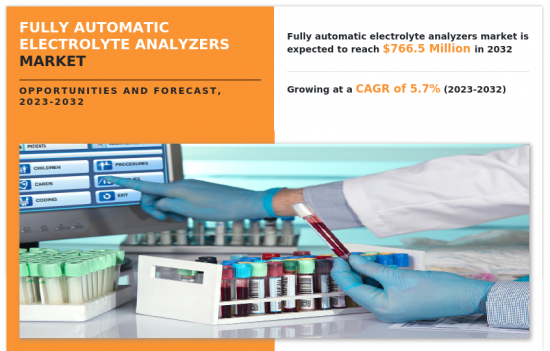
|
시장보고서
상품코드
1365811
전자동 전해질 분석기 시장 : 유형별, 모달리티별, 최종사용자별 - 세계 기회 분석과 산업 예측(2023-2032년)Fully Automatic Electrolyte Analyzers Market By Type (Standalone, Integrated), By Modality (Portable, Benchtop), By End User (Hospitals, Diagnostic Centers, Others): Global Opportunity Analysis and Industry Forecast, 2023-2032 |
||||||
전자동 전해질 분석기 시장은 의료기기 업계로부터의 수요 증가에 의해 2023-2032년 5.7%의 대폭적인 성장률을 기록할 것으로 보입니다.

전자동 전해질 분석기 시장 성장의 원동력은 최신 의료 기술에 대한 수요 증가, 의료의 분산화 추세 증가, 당뇨병, 관상동맥질환, 고혈압 등 장기 질환의 유병률 급증입니다. 고혈압과 같은 장기적인 질병은 나트륨과 칼륨 이온의 손실로 인해 체내 전해질 불균형을 유발합니다. 따라서 전자동 전해질 분석기는 의료 전문가가 고혈압으로 고통받는 환자의 전해질 균형을 관리하는 편리한 방법을 제공하는 데 사용됩니다. 예를 들어 2020년 범미보건기구(PAHO)는 고혈압이 세계 성인 인구의 30% 이상에 영향을 미칠 것으로 추정하고 있습니다. 만성질환의 유병률이 증가함에 따라 전자동 전해질 분석기에 대한 수요가 증가하고 있으며, 이는 시장 성장을 가속하는 주요 요인으로 작용하고 있습니다.
또한 전자동 전해질 분석기의 기술 발전은 전해질 측정의 정확도와 정밀도를 크게 향상시켜 시장 성장에 기여하고 있습니다. 예를 들어 Cobas b 221 시스템은 완전 자동화된 탁상형 분석기이며, 개별적으로 조정 가능한 매개변수 구성을 갖추고 있습니다. 또한 이 시스템은 병원이나 검사실뿐만 아니라 현장 검사에서도 작동할 수 있습니다. 이러한 기술적으로 진보된 자동 전해질 분석기의 가용성은 시장 성장에 더욱 기여하고 있습니다.
목차
제1장 서론
제2장 주요 요약
제3장 시장 개요
- 시장의 정의와 범위
- 주요 조사 결과
- 영향요인
- 주요 투자 기회
- Porter's Five Forces 분석
- 시장 역학
- 촉진요인
- 전자동 전해질 분석기 기술 진보
- 장기 질환의 증가
- POC(Point of Care) 검사 수요의 급증
- 억제요인
- 전자동 전해질 분석기의 고비용
- 기회
- 예방 헬스케어에 대한 관심의 증가
- 촉진요인
제4장 전자동 전해질 분석기 시장 : 유형별
- 개요
- 스탠드얼론형
- 통합형
제5장 후르오트마틱크 전기 분석기 시장 : 형태별
- 개요
- 휴대용
- 벤치톱
제6장 후르오트마틱크 전기 분석기 시장 : 최종사용자별
- 개요
- 병원
- 진단 센터
- 기타
제7장 후르오트마틱크 전자 분석기 시장 후르오트마틱크 전기 분석기 시장 : 지역별
- 개요
- 북미
- 미국
- 캐나다
- 멕시코
- 유럽
- 독일
- 프랑스
- 영국
- 이탈리아
- 스페인
- 기타
- 아시아태평양
- 일본
- 중국
- 인도
- 호주
- 한국
- 기타
- 라틴아메리카·중동 및 아프리카
- 브라질
- 사우디아라비아
- 남아프리카공화국
- 기타
제8장 경쟁 상황
- 서론
- 주요 성공 전략
- 주요 10 기업의 제품 매핑
- 경쟁 대시보드
- 경쟁 히트맵
- 주요 기업의 포지셔닝, 2022년
제9장 기업 개요
- Agappe Diagnostics Ltd
- Accurex Biomedical Pvt. Ltd.
- Caretium Medical Instruments Co.
- Diamond Diagnostics
- Medica Corporation
- Neomedica
- F. Hoffmann-La Roche Ltd.
- Abbott Laboratories
- HD Consortium India Limited
- Siemens AG
The fully automatic electrolyte analyzers market is likely to experience a significant growth rate of 5.7% from 2023-2032 owing to rise in demand from medical device industry- Allied Market Research

The fully automatic electrolyte analyzers market growth is driven by increase in need for modern healthcare technology, rise in trend towards decentralized medical care, and surge in prevalence of long-term illnesses such as diabetes, coronary artery disease, and hypertension. Long-term illnesses such as hypertension cause electrolyte imbalances in the body due to loss of sodium and potassium ions. Therefore, fully automated electrolyte analyzers are used to offer convenient methods for healthcare professionals to manage electrolyte balances in patients suffering from hypertension. For instance, in 2020, Pan American Health Organization (PAHO), estimated that hypertension affects more than 30% of the adult population across the globe. As the prevalence of chronic disease is rising, there is a greater need for fully automated electrolyte analyzers which is the key factor driving the growth of the market.
Furthermore, technological advancement in fully automated electrolyte analyzers has significantly improved the accuracy and precision of electrolyte measurements and contributed towards market growth. For instance, Cobas b 221 system is a fully automated benchtop analyzer which offers individually adjustable parameter configurations. In addition, this system can be operated in hospitals and laboratories, as well as in point-of-care testing. Availability of such technologically advanced automated electrolyte analyzers further contribute towards the market growth.
In addition, the medical facilities in India represent a complex scenario as the country has most diverse population in the world with limited healthcare resources. Therefore, the utility of point-of-care diagnostic devices are uplifting the healthcare status in India. Therefore, the increase in demand for point of care testing further propels the market growth of fully automatic electrolyte analyzers.
However, the excessive cost of fully automatic electrolyte analyzers as compared with semi-automated or manual analyzers negatively impacts the market growth. High cost of automatic electrolyte analyzers as well as ongoing maintenance and reagent expenses, raise the overall cost and limit their adoption in healthcare facilities, especially in smaller clinics or laboratories with limited budgets.
On the other hand, increase in demand for portable automatic electrolyte analyzers for preventive care and diverse parameters testing through integrated automatic electrodes are expected to create immense opportunities for the growth of fully automatic electrolyte analyzers market during the forecast period. The fully automatic electrolyte analyzers market is segmented on the basis of type, modality, end user, and region. On the basis of type, the market is classified into standalone and integrated.
On the basis of modality, the market is bifurcated into benchtop and portable. As per end user, the market is divided into hospitals, diagnostic centers, and others. Others segment includes clinics, homecare settings, and ambulatory surgical centers. Region wise, the market is analyzed across North America (U.S., Canada, and Mexico), Europe (Germany, France, UK, Italy, Spain, and rest of Europe), Asia-Pacific (China, Japan, Australia, India, South Korea, and rest of Asia-Pacific), and LAMEA (Brazil, South Africa, Saudi Arabia, and rest of LAMEA).
Major key players that operate in the global fully automatic electrolyte analyzers market are Accurex Biomedical Pvt. Ltd., Medica Corporation, F. Hoffmann-La Roche Ltd., Abbott Laboratories, Caretium Medical Instruments Co., Diamond Diagnostics, Neomedica, Agappe Diagnostics Ltd, Siemens AG, and HD Consortium India Limited.
Key Benefits For Stakeholders
- This report provides a quantitative analysis of the market segments, current trends, estimations, and dynamics of the fully automatic electrolyte analyzers market analysis from 2022 to 2032 to identify the prevailing fully automatic electrolyte analyzers market opportunities.
- The market research is offered along with information related to key drivers, restraints, and opportunities.
- Porter's five forces analysis highlights the potency of buyers and suppliers to enable stakeholders make profit-oriented business decisions and strengthen their supplier-buyer network.
- In-depth analysis of the fully automatic electrolyte analyzers market segmentation assists to determine the prevailing market opportunities.
- Major countries in each region are mapped according to their revenue contribution to the global market.
- Market player positioning facilitates benchmarking and provides a clear understanding of the present position of the market players.
- The report includes the analysis of the regional as well as global fully automatic electrolyte analyzers market trends, key players, market segments, application areas, and market growth strategies.
Additional benefits you will get with this purchase are:
- Quarterly Update and* (only available with a corporate license, on listed price)
- 5 additional Company Profile of client Choice pre- or Post-purchase, as a free update.
- Free Upcoming Version on the Purchase of Five and Enterprise User License.
- 16 analyst hours of support* (post-purchase, if you find additional data requirements upon review of the report, you may receive support amounting to 16 analyst hours to solve questions, and post-sale queries)
- 15% Free Customization* (in case the scope or segment of the report does not match your requirements, 20% is equivalent to 3 working days of free work, applicable once)
- Free data Pack on the Five and Enterprise User License. (Excel version of the report)
- Free Updated report if the report is 6-12 months old or older.
- 24-hour priority response*
- Free Industry updates and white papers.
Possible Customization with this report (with additional cost and timeline talk to the sales executive to know more)
- Regulatory Guidelines
- Additional company profiles with specific to client's interest
- Additional country or region analysis- market size and forecast
- Expanded list for Company Profiles
- Historic market data
Key Market Segments
By Type
- Standalone
- Integrated
By Modality
- Portable
- Benchtop
By End User
- Hospitals
- Diagnostic Centers
- Others
By Region
- North America
- U.S.
- Canada
- Mexico
- Europe
- Germany
- France
- UK
- Italy
- Spain
- Rest of Europe
- Asia-Pacific
- Japan
- China
- India
- Australia
- South Korea
- Rest of Asia-Pacific
- LAMEA
- Brazil
- Saudi Arabia
- South Africa
- Rest of LAMEA
Key Market Players:
- Diamond Diagnostics
- Medica Corporation
- Abbott Laboratories
- Agappe Diagnostics Ltd
- HD Consortium India Limited
- Neomedica
- Caretium Medical Instruments Co.
- F. Hoffmann-La Roche Ltd.
- Siemens AG
- Accurex Biomedical Pvt. Ltd.
TABLE OF CONTENTS
CHAPTER 1: INTRODUCTION
- 1.1. Report description
- 1.2. Key market segments
- 1.3. Key benefits to the stakeholders
- 1.4. Research Methodology
- 1.4.1. Primary research
- 1.4.2. Secondary research
- 1.4.3. Analyst tools and models
CHAPTER 2: EXECUTIVE SUMMARY
- 2.1. CXO Perspective
CHAPTER 3: MARKET OVERVIEW
- 3.1. Market definition and scope
- 3.2. Key findings
- 3.2.1. Top impacting factors
- 3.2.2. Top investment pockets
- 3.3. Porter's five forces analysis
- 3.3.1. Moderate bargaining power of suppliers
- 3.3.2. Moderate threat of new entrants
- 3.3.3. Low threat of substitutes
- 3.3.4. Moderate intensity of rivalry
- 3.3.5. Moderate bargaining power of buyers
- 3.4. Market dynamics
- 3.4.1. Drivers
- 3.4.1.1. Technological advancements in fully automatic electrolyte analyzers
- 3.4.1.2. Increase in prevalence of long-term diseases
- 3.4.1.3. Surge in demand for point-of-care testing
- 3.4.2. Restraints
- 3.4.2.1. High cost of fully automated electrolyte analyzers
- 3.4.3. Opportunities
- 3.4.3.1. Growing focus on preventive healthcare
- 3.4.1. Drivers
CHAPTER 4: FULLY AUTOMATIC ELECTROLYTE ANALYZERS MARKET, BY TYPE
- 4.1. Overview
- 4.1.1. Market size and forecast
- 4.2. Standalone
- 4.2.1. Key market trends, growth factors and opportunities
- 4.2.2. Market size and forecast, by region
- 4.2.3. Market share analysis by country
- 4.3. Integrated
- 4.3.1. Key market trends, growth factors and opportunities
- 4.3.2. Market size and forecast, by region
- 4.3.3. Market share analysis by country
CHAPTER 5: FULLY AUTOMATIC ELECTROLYTE ANALYZERS MARKET, BY MODALITY
- 5.1. Overview
- 5.1.1. Market size and forecast
- 5.2. Portable
- 5.2.1. Key market trends, growth factors and opportunities
- 5.2.2. Market size and forecast, by region
- 5.2.3. Market share analysis by country
- 5.3. Benchtop
- 5.3.1. Key market trends, growth factors and opportunities
- 5.3.2. Market size and forecast, by region
- 5.3.3. Market share analysis by country
CHAPTER 6: FULLY AUTOMATIC ELECTROLYTE ANALYZERS MARKET, BY END USER
- 6.1. Overview
- 6.1.1. Market size and forecast
- 6.2. Hospitals
- 6.2.1. Key market trends, growth factors and opportunities
- 6.2.2. Market size and forecast, by region
- 6.2.3. Market share analysis by country
- 6.3. Diagnostic Centers
- 6.3.1. Key market trends, growth factors and opportunities
- 6.3.2. Market size and forecast, by region
- 6.3.3. Market share analysis by country
- 6.4. Others
- 6.4.1. Key market trends, growth factors and opportunities
- 6.4.2. Market size and forecast, by region
- 6.4.3. Market share analysis by country
CHAPTER 7: FULLY AUTOMATIC ELECTROLYTE ANALYZERS MARKET, BY REGION
- 7.1. Overview
- 7.1.1. Market size and forecast By Region
- 7.2. North America
- 7.2.1. Key market trends, growth factors and opportunities
- 7.2.2. Market size and forecast, by Type
- 7.2.3. Market size and forecast, by Modality
- 7.2.4. Market size and forecast, by End User
- 7.2.5. Market size and forecast, by country
- 7.2.5.1. U.S.
- 7.2.5.1.1. Market size and forecast, by Type
- 7.2.5.1.2. Market size and forecast, by Modality
- 7.2.5.1.3. Market size and forecast, by End User
- 7.2.5.2. Canada
- 7.2.5.2.1. Market size and forecast, by Type
- 7.2.5.2.2. Market size and forecast, by Modality
- 7.2.5.2.3. Market size and forecast, by End User
- 7.2.5.3. Mexico
- 7.2.5.3.1. Market size and forecast, by Type
- 7.2.5.3.2. Market size and forecast, by Modality
- 7.2.5.3.3. Market size and forecast, by End User
- 7.3. Europe
- 7.3.1. Key market trends, growth factors and opportunities
- 7.3.2. Market size and forecast, by Type
- 7.3.3. Market size and forecast, by Modality
- 7.3.4. Market size and forecast, by End User
- 7.3.5. Market size and forecast, by country
- 7.3.5.1. Germany
- 7.3.5.1.1. Market size and forecast, by Type
- 7.3.5.1.2. Market size and forecast, by Modality
- 7.3.5.1.3. Market size and forecast, by End User
- 7.3.5.2. France
- 7.3.5.2.1. Market size and forecast, by Type
- 7.3.5.2.2. Market size and forecast, by Modality
- 7.3.5.2.3. Market size and forecast, by End User
- 7.3.5.3. UK
- 7.3.5.3.1. Market size and forecast, by Type
- 7.3.5.3.2. Market size and forecast, by Modality
- 7.3.5.3.3. Market size and forecast, by End User
- 7.3.5.4. Italy
- 7.3.5.4.1. Market size and forecast, by Type
- 7.3.5.4.2. Market size and forecast, by Modality
- 7.3.5.4.3. Market size and forecast, by End User
- 7.3.5.5. Spain
- 7.3.5.5.1. Market size and forecast, by Type
- 7.3.5.5.2. Market size and forecast, by Modality
- 7.3.5.5.3. Market size and forecast, by End User
- 7.3.5.6. Rest of Europe
- 7.3.5.6.1. Market size and forecast, by Type
- 7.3.5.6.2. Market size and forecast, by Modality
- 7.3.5.6.3. Market size and forecast, by End User
- 7.4. Asia-Pacific
- 7.4.1. Key market trends, growth factors and opportunities
- 7.4.2. Market size and forecast, by Type
- 7.4.3. Market size and forecast, by Modality
- 7.4.4. Market size and forecast, by End User
- 7.4.5. Market size and forecast, by country
- 7.4.5.1. Japan
- 7.4.5.1.1. Market size and forecast, by Type
- 7.4.5.1.2. Market size and forecast, by Modality
- 7.4.5.1.3. Market size and forecast, by End User
- 7.4.5.2. China
- 7.4.5.2.1. Market size and forecast, by Type
- 7.4.5.2.2. Market size and forecast, by Modality
- 7.4.5.2.3. Market size and forecast, by End User
- 7.4.5.3. India
- 7.4.5.3.1. Market size and forecast, by Type
- 7.4.5.3.2. Market size and forecast, by Modality
- 7.4.5.3.3. Market size and forecast, by End User
- 7.4.5.4. Australia
- 7.4.5.4.1. Market size and forecast, by Type
- 7.4.5.4.2. Market size and forecast, by Modality
- 7.4.5.4.3. Market size and forecast, by End User
- 7.4.5.5. South Korea
- 7.4.5.5.1. Market size and forecast, by Type
- 7.4.5.5.2. Market size and forecast, by Modality
- 7.4.5.5.3. Market size and forecast, by End User
- 7.4.5.6. Rest of Asia-Pacific
- 7.4.5.6.1. Market size and forecast, by Type
- 7.4.5.6.2. Market size and forecast, by Modality
- 7.4.5.6.3. Market size and forecast, by End User
- 7.5. LAMEA
- 7.5.1. Key market trends, growth factors and opportunities
- 7.5.2. Market size and forecast, by Type
- 7.5.3. Market size and forecast, by Modality
- 7.5.4. Market size and forecast, by End User
- 7.5.5. Market size and forecast, by country
- 7.5.5.1. Brazil
- 7.5.5.1.1. Market size and forecast, by Type
- 7.5.5.1.2. Market size and forecast, by Modality
- 7.5.5.1.3. Market size and forecast, by End User
- 7.5.5.2. Saudi Arabia
- 7.5.5.2.1. Market size and forecast, by Type
- 7.5.5.2.2. Market size and forecast, by Modality
- 7.5.5.2.3. Market size and forecast, by End User
- 7.5.5.3. South Africa
- 7.5.5.3.1. Market size and forecast, by Type
- 7.5.5.3.2. Market size and forecast, by Modality
- 7.5.5.3.3. Market size and forecast, by End User
- 7.5.5.4. Rest of LAMEA
- 7.5.5.4.1. Market size and forecast, by Type
- 7.5.5.4.2. Market size and forecast, by Modality
- 7.5.5.4.3. Market size and forecast, by End User
CHAPTER 8: COMPETITIVE LANDSCAPE
- 8.1. Introduction
- 8.2. Top winning strategies
- 8.3. Product Mapping of Top 10 Player
- 8.4. Competitive Dashboard
- 8.5. Competitive Heatmap
- 8.6. Top player positioning, 2022
CHAPTER 9: COMPANY PROFILES
- 9.1. Agappe Diagnostics Ltd
- 9.1.1. Company overview
- 9.1.2. Key Executives
- 9.1.3. Company snapshot
- 9.1.4. Operating business segments
- 9.1.5. Product portfolio
- 9.2. Accurex Biomedical Pvt. Ltd.
- 9.2.1. Company overview
- 9.2.2. Key Executives
- 9.2.3. Company snapshot
- 9.2.4. Operating business segments
- 9.2.5. Product portfolio
- 9.3. Caretium Medical Instruments Co.
- 9.3.1. Company overview
- 9.3.2. Key Executives
- 9.3.3. Company snapshot
- 9.3.4. Operating business segments
- 9.3.5. Product portfolio
- 9.4. Diamond Diagnostics
- 9.4.1. Company overview
- 9.4.2. Key Executives
- 9.4.3. Company snapshot
- 9.4.4. Operating business segments
- 9.4.5. Product portfolio
- 9.5. Medica Corporation
- 9.5.1. Company overview
- 9.5.2. Key Executives
- 9.5.3. Company snapshot
- 9.5.4. Operating business segments
- 9.5.5. Product portfolio
- 9.6. Neomedica
- 9.6.1. Company overview
- 9.6.2. Key Executives
- 9.6.3. Company snapshot
- 9.6.4. Operating business segments
- 9.6.5. Product portfolio
- 9.7. F. Hoffmann-La Roche Ltd.
- 9.7.1. Company overview
- 9.7.2. Key Executives
- 9.7.3. Company snapshot
- 9.7.4. Operating business segments
- 9.7.5. Product portfolio
- 9.7.6. Business performance
- 9.8. Abbott Laboratories
- 9.8.1. Company overview
- 9.8.2. Key Executives
- 9.8.3. Company snapshot
- 9.8.4. Operating business segments
- 9.8.5. Product portfolio
- 9.8.6. Business performance
- 9.9. HD Consortium India Limited
- 9.9.1. Company overview
- 9.9.2. Key Executives
- 9.9.3. Company snapshot
- 9.9.4. Operating business segments
- 9.9.5. Product portfolio
- 9.10. Siemens AG
- 9.10.1. Company overview
- 9.10.2. Key Executives
- 9.10.3. Company snapshot
- 9.10.4. Operating business segments
- 9.10.5. Product portfolio
- 9.10.6. Business performance



















